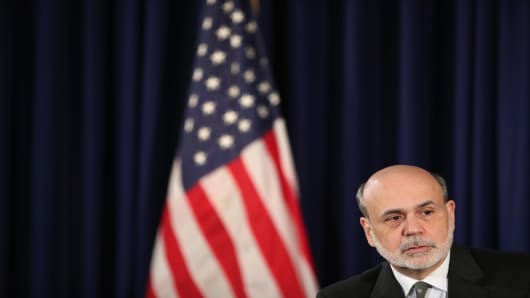The U.S. will not end its quantitative easing program before 2014, according to Christian Menegatti, managing director of research at Roubini Global Economics.
Menegatti, who works alongside well-known economist Nouriel Roubini, said quantitative easing will continue throughout 2013 and an interest rate cut will not be on the cards until 2015.
The U.S. central bank has kept benchmark interest rates close to zero since 2009 and has tried to stimulate the economy also through three rounds of quantitative easing, or bond purchases. The third round was implemented in September last year, known as QE3.
"We are talking about 2014, in terms of winding down quantitative easing. We'll have to wait much longer for rate hikes ... well into 2015 and maybe towards the end of it," said Menegatti.
(Read More: Nouriel Roubini: Brace for Market Correction Later This Year)
This would spell good news for equity markets, which have gotten used to the flow of easy money. Wall Street's Dow Jones Industrial Average, which logged a fresh record on Tuesday, has rallied almost 12 percent so far this year.
However, the rally has been mixed with a touch of fear in recent weeks after the Federal Reserve's minutes late February hinted that the end of QE maybe coming — a move which could suck liquidity out of markets and derail the strong recovery seen in the U.S. and across global markets.
A drop in unemployment numbers for February to 7.7 percent, with 236,000 new jobs created also ramped up fears that the Fed may start tightening.
In December, the Fed said a 6.5 percent unemployment rate would be a trigger for tightening monetary policy and raising interest rates.
(Read More: Fed Talk onSlowing QE Hits Stocks)
"With the latest number last week [the 7.5 percent unemployment rate] the devil is in the detail. The Fed will not just look at unemployment it will look holistically at labor markets and will look at whether improvements are caused by people leaving the work force or actual job creation," said Menegatti.
"The Fed has sent a signal that at 7.25 percent they will start winding down QE. We think it will take a while to get there and we don't expect to get there before the end of 2013. By then we will be somewhere between 7.5 and 7.7 percent depending on what happens with 'sequestration,' " he added.
Investors have recently been fretting over the implications of the sequestration, an extensive round of budget cuts across defense, transportation, Social Security, and health care, and their potential to impinge on the economy.
(Read More: Want the Fed to Tighten? Don't Hold Your Breath)
Menegatti added the polarization of views between the Democrat and Republican politicians remained a key risk to the U.S. economy.
He warned that the U.S. government could face another downgrade, if bickering over how to tackle the debt ceiling crisis continues. The U.S. lost its prized triple-A credit rating from Standard & Poor's credit rating agency in August 2011.
"Polarization is the word of the day and that's what caused the downgrade in 2011 and who knows, that's what we might get again," he said.
However, markets have proven resilient to the headwind and have continued to climb regardless. Menegatti said this resilience was due to the fact that investors now have renewed faith in the U.S. government.
"The market has been trained and learned that at the 11th hour we get a solution to these things. The market is looking at the fundamentals in the U.S. which are better than many other parts of the advanced world. The market is pricing in the fact that the Fed might take a bit more insurance rather than let this recovery fade away again," he added.
Investors have turned more bullish on progress within the U.S. after a deal that prevented the economy from falling off the "fiscal cliff" of tax hikes and spending cuts on Jan. 1. Plus the recent jobs data have added to optimism over the state of the world's largest economy.



